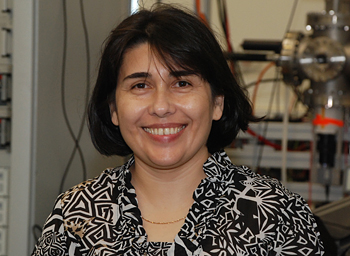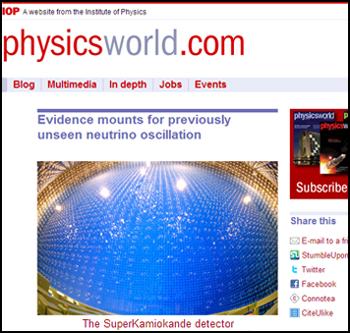Mysteries of the neutrino
Fri, 09 Nov 2012 13:18:00 GMT
Huddersfield physicists join global partners for an investigation of the Big Bang particle
 SCIENTISTS at the University of Huddersfield are collaborating with experts at some of the world’s leading research institutes in an attempt to unravel the mysteries of a particle that played a role in the creation of the universe.
SCIENTISTS at the University of Huddersfield are collaborating with experts at some of the world’s leading research institutes in an attempt to unravel the mysteries of a particle that played a role in the creation of the universe.
The existence of neutrinos and anti-neutrinos – particles that are almost massless and which travel at light speed from one side of the earth to the other – was confirmed more than 50 years ago. Scientists believe that they were created at the Big Bang and might hold the key to the nature of the universe.
But they are light particles that react weakly with matter and they change properties as they travel. This process – named neutrino oscillation – makes the particles highly elusive.
“To study them you have to produce them at very high rates and my research is all about maximising anti-neutrino production,” says Dr Adriana Bungau, a research fellow at the University of Huddersfield and a member of its International Institute for Accelerator Applications.
She is the lead author of an article dealing with her research that has recently been published in the leading journal Physical Review Letters. This earned a fresh accolade when the article was then selected for highlighting by the website Physics, which aims to spotlight exceptional research (see http://physics.aps.org/synopsis-for/10.1103/PhysRevLett.109.141802).
Dr Bungau is part of an international project to design and construct a new accelerator which will use a low-energy cyclotron to direct proton beams at a target consisting of a cylinder of beryllium-9, itself surrounded by a refrigerator-sized cylinder of lithium-7. This would result in the continuous creation of lithium-8 isotopes that would rapidly decay, producing huge numbers of anti-neutrinos, which could then be used in practical experiments.
 International partners
International partners
Dr Bungau and University of Huddersfield colleagues are working with international partners on design and funding proposals for the new facility, probably to be built in Japan, which already has a neutrino-detector named KamLAND. Other participants in the project include the Massachusetts Institute of Technology and Columbia University in New York, plus the Paul Scherrer Institute in Switzerland and the Institute Internationale Frascati in Italy.
Dr Bungau’s specialist role is to design the target and surrounding components by carrying out intensive computer simulations.
“We have come up with an optimum design in order to get a higher rate of lithium-8,” said Dr Bungau.
“We did that by surrounding the target with heavy water, which means that the neutrons which were chipped off by the proton impact are slowed down to very low energies, so they can be captured in the surrounding environment made of lithium-7.”
This results in a tenfold increase in lithium-8 production, according to Dr Bungau, although she is aiming for more as the project progresses.
She believes passionately that improved understanding of particles will open up fresh horizons. “It is all about pushing the limits of science,” says Dr Bungau.
- The article Proposal for an Electron Antineutrino Disappearance Search Using High-Rate 8Li Production and Decay by A. Bungau, A. Adelmann, J. R. Alonso, W. Barletta, R. Barlow, L. Bartoszek, L. Calabretta, A. Calanna, D. Campo, J. M. Conrad, Z. Djurcic, Y. Kamyshkov, M. H. Shaevitz, I. Shimizu, T. Smidt, J. Spitz, M. Wascko, L. A. Winslow, and J. J. Yang is published in Physical Review Letters. 109, 141802 (2012) Published October 4, 2012.







